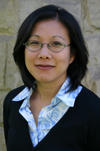The Harvard Family Research Project separated from the Harvard Graduate School of Education to become the Global Family Research Project as of January 1, 2017. It is no longer affiliated with Harvard University.

|
April 24, 2014 Seamless and Connected—Education in the Digital AgeMizuko Ito
|
FINE Newsletter, Volume VI, Issue 2
Issue Topic: Making it Real—Connected Learning in the Digital Age
Perspectives
Mizuko Ito examines innovative strategies and engaging digital media activities that allow educational institutions to connect young people’s learning to their social lives, communities, interests, and careers.
“I’ve always been fascinated by how people learn, particularly self-directed learners. I’m not one of them myself, but my brother was. He didn’t like formal education, but he would just learn on his own. When he was interested in fish, he got to know the guys at the aquarium shop, and every day he would go after school and hang out with them, and that’s how he learned with whatever he would become interested in. It’s actually quite hard to learn that way. You have to be charming and extroverted and have supportive parents. He was a special case, but it made me wonder why we can’t support more kids to learn in ways that are more social and integrated with the real world.” (Excerpt from Q&A: Mizuko Ito on Connected Learning for All)
As educators, parents, policymakers, and learners, we need to take a hard look at our own role in how to make the most of the opportunities for learning, especially those that come with our open, networked, online world. Young people today are constantly connected and have information at their fingertips in ways that are transforming how they learn and socialize. It’s critical that we leverage new technology to build stronger connections between our educational institutions and the world at large.
This is not a new agenda. It’s what John Dewey talked about many decades ago. Education needs to be seamless with life—this view should be central to the public mission of our educational institutions in the digital age. Education is not just about delivering expertise and content, especially in an era when information and knowledge are abundant. And it shouldn’t be primarily about assessment and credentialing, particularly when we are seeing that learning happens anywhere, anytime, and that the demand for learning never stops. Educational institutions need to connect young people’s learning to their social lives, their communities, their interests, and their careers.
Connected learning involves diverse learning institutions committed to providing youth with a range of experiences to develop their knowledge and expertise based on their unique interests and potential. Through connected learning, institutions like schools, museums, and libraries can, and already are, taking part in innovative strategies, leveraging digital media to make learning more relevant and engaging to youth, and linking the three crucial spheres in a learner’s life—peers, interests, and academic pursuits.
| Connected Learning is an educational approach designed for a rapidly changing world. It makes learning relevant to all populations, to real life and real work, and to the realities of the digital age, where the demand for learning never stops. Connected learning seeks to integrate three spheres of learning that are often disconnected and at war with each other in young people’s lives: peer culture, interests, and academic content. (Connected Learning Research Network [2013]. About connected learning. Retrieved from http://connectedlearning.tv/what-is-connected-learning) |
One great example is the Learning Labs project. This project supports approximately 24 spaces in museums and libraries nationwide where youth can pursue interest-driven activities using both digital and traditional media. Each site offers such activities as graphic and visual arts, spoken-word and music performances, blogging, journal and video game reviews, making and tinkering, photography, digital music and video production, CAD design and 3-D printing, game and e-book production, and fan fiction clubs. Four of the sites are participating in larger Hive Learning Networks, which are emerging in New York, San Francisco, and Pittsburgh, where they are connecting with other local education partners.
Quest to Learn, a New York public school that engages students in collaborative and game-like learning, provides another example of the power of connected learning. This innovative school supports the kinds of connections required to knit together and leverage all the opportunities for learning that exist in a student’s life, online and in the world at large.
All young people deserve to have these kinds of meaningful and relevant educational experiences, yet we are seeing growing inequity in access to enriched learning. The Internet, social media, and digital technology give us the potential to expand the capacity of our public educational system and to reach all youth in their diverse communities and with their wide-ranging interests. Realizing this potential will require concerted, proactive efforts for change on behalf of those of us who are open and committed to an expansive and equitable approach to public education.
Mizuko Ito is a cultural anthropologist who studies technology use and young people’s changing relationships with media and communications. She is Professor in Residence and John D. and Catherine T. MacArthur Foundation Chair in Digital Media and Learning at the University of California, Irvine. She also serves as research director of the Digital Media and Learning Hub at UC Irvine and chair of the MacArthur Research Network on Connected Learning.
This resource is part of the April FINE Newsletter. The FINE Newsletter shares the newest and best family engagement research and resources from Harvard Family Research Project and other field leaders. To access the archives of past issues, please visit www.hfrp.org/FINENewsletter.

